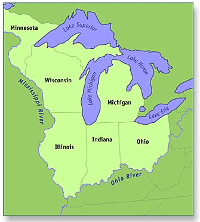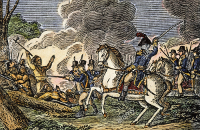The Battle of Fallen Timbers
The Battle of Fallen Timbers was a victory for the United States Army against an alliance of Native Americans. The 1794 battle took place near what is now Toledo, Ohio, and essentially decided the course of settlement in that part of the U.S. The Treaty of Paris that ended the Revolutionary War had handed control of this area over to the Americans, but British forces did not abandon their forts. British troops also actively supported Native Americans in their efforts to hold on to their lands in the face of continued American settlement. Faced with consecutive defeats at the hands of the various tribes, President George Washington appointed Major General Anthony Wayne to command the U.S. Army in the Northwest Territory, a vast amount of land that Congress had created in a 1787 ordinance designed to encourage settlement in what is now Illinois, Indiana, Michigan, Minnesota, Ohio, and Wisconsin. The area had been the ancestral home of many Native American tribes for a great many years. Like most of the rest of the U.S., it was the scene of conflicts between Native Americans and Americans; many of those conflicts were violent. The ordinance had made some provisions for protecting land on which Native Americans lived, but many American settlers ignored those provisions. Wayne, who gained the name "Mad Anthony" for his daring storming of a British fort during the Revolutionary War Battle of Stony Point, had been among the leaders of the American forces at Yorktown, the last major battle of the Revolutionary War. After that, he had negotiated treaties with the Cherokee and Creek tribes in Georgia. Washington was counting on both areas of Wayne's expertise. The colorful Wayne took charge of the area's militias and turned them into more of a professional army known as the Legion of the United States. Wayne was aiming to succeed where two of his predecessors, Josiah Harmar and Arthur St. Clair, had failed. Both had engaged Native American forces on the field of battle and had been defeated. Harmar made relatively little progress in 1790, losing dozens of men in skirmish after skirmish. St. Clair fared no better, suffering a particularly disastrous defeat in 1791 that claimed the lives of more than 600 people. Wayne had brought a contingent of professionally trained troops and arrived at Fort Washington, near what is now Cincinnati, in May 1793. The troops drilled and drilled, aiming to avoid past mistakes. They moved from fort to fort, eventually building a new one, Fort Greene Ville, where they spent the winter. The men also built Fort Recovery, on the site of St. Clair's defeat. The territory was large, and both Wayne's force and what would end up being his main enemy operated in different areas for a time. Leading the alliance of Native Americans were Miami chief Little Turtle, Shawnee chief Blue Jacket, another Shawnee fighter who would rise to prominence named Tecumseh, and members of the Lenape, Myaamia, Ojibwa, Ottawa, and Wyandot tribes. On June 30, 1794, Little Turtle and 1,500 other Native Americans attacked a supply train leaving Fort Recovery, killing or capturing many of the Americans and seizing the supplies. As a result, Wayne ordered the construction of another fort, Fort Defiance. He also ordered his men to destroy the homes and crops of many Native Americans living nearby. By this time, Wayne had a fighting force of 3,000 well trained men. The Native American alliance had lost a significant number for various reasons and had not been replenished, and the remaining force was about half that of the Americans. Both sides prepared for conflict. Wayne's forces marched up the Maumee River. The Native American alliance chose the battlefield, near where a number of trees had been felled by a tornado. The battle occurred on August 20. Among the leaders of the Native American alliance that day were Blue Jacket, Little Turtle, Lenape chief Buckongahelas, Ottawa chief Turkey Foot, and Wyandot chief Roundhead. The American forces won the day. American deaths numbered 33, with 100 wounded. Native American casualties were about twice that. Blue Jacket and his followers moved to Fort Miami, looking for support from British forces, who were still very much in the area. This time, the fort would not open its doors. Wayne arrived and ordered the British to leave the territory; he was rebuffed. Wayne set up headquarters at Fort Greene Ville and spent the next year working out the terms of a treaty with leaders of the various tribes. The result was the Treaty of Greenville, signed nearly a year after the Battle of Fallen Timbers. Tribal leaders agreed to give up their lands to American settlers and move to the northwestern part of what is now Ohio. Tensions between Native Americans and Americans remained. In particular, the Shawnee fighter Tecumseh would step into the void left by the death or retirement of some tribal leaders and create his own alliance a few years later. Tensions between Americans and British would erupt into open war in 1812. |
|
Social Studies for Kids
copyright 2002–2025
David White








